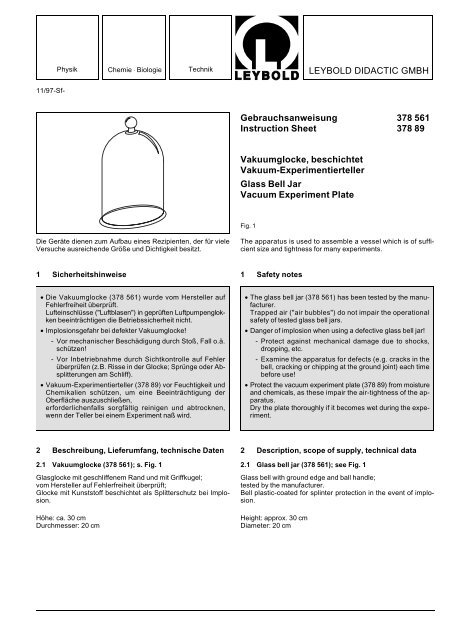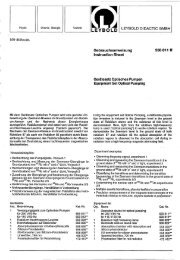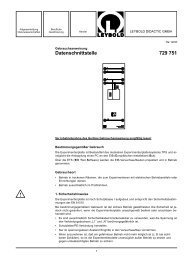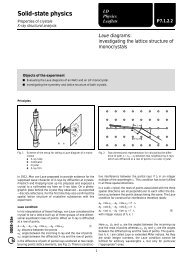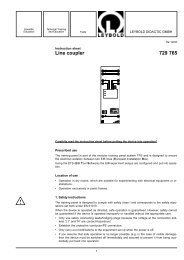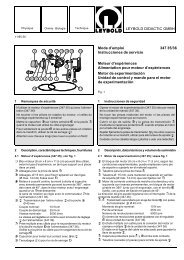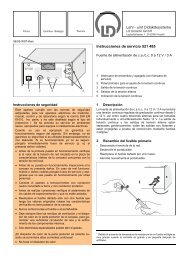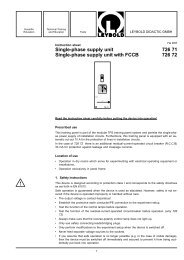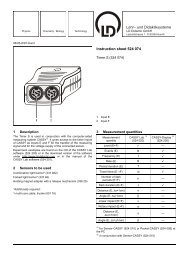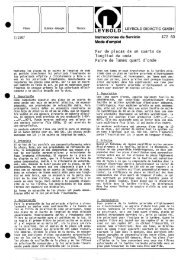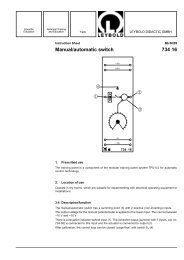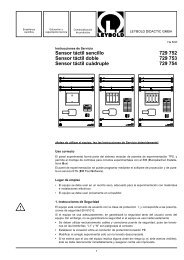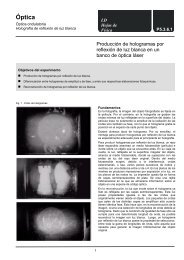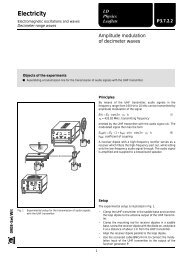LEYBOLD DIDACTIC GMBH Gebrauchsanweisung 378 561 ...
LEYBOLD DIDACTIC GMBH Gebrauchsanweisung 378 561 ...
LEYBOLD DIDACTIC GMBH Gebrauchsanweisung 378 561 ...
Erfolgreiche ePaper selbst erstellen
Machen Sie aus Ihren PDF Publikationen ein blätterbares Flipbook mit unserer einzigartigen Google optimierten e-Paper Software.
11/97-Sf-<br />
Physik Chemie ⋅ Biologie Technik <strong>LEYBOLD</strong> <strong>DIDACTIC</strong> <strong>GMBH</strong><br />
Die Geräte dienen zum Aufbau eines Rezipienten, der für viele<br />
Versuche ausreichende Größe und Dichtigkeit besitzt.<br />
1 Sicherheitshinweise<br />
• Die Vakuumglocke (<strong>378</strong> <strong>561</strong>) wurde vom Hersteller auf<br />
Fehlerfreiheit überprüft.<br />
Lufteinschlüsse ("Luftblasen") in geprüften Luftpumpenglokken<br />
beeinträchtigen die Betriebssicherheit nicht.<br />
• Implosionsgefahr bei defekter Vakuumglocke!<br />
- Vor mechanischer Beschädigung durch Stoß, Fall o.ä.<br />
schützen!<br />
- Vor Inbetriebnahme durch Sichtkontrolle auf Fehler<br />
überprüfen (z.B. Risse in der Glocke; Sprünge oder Absplitterungen<br />
am Schliff).<br />
• Vakuum-Experimentierteller (<strong>378</strong> 89) vor Feuchtigkeit und<br />
Chemikalien schützen, um eine Beeinträchtigung der<br />
Oberfläche auszuschließen,<br />
erforderlichenfalls sorgfältig reinigen und abtrocknen,<br />
wenn der Teller bei einem Experiment naß wird.<br />
2 Beschreibung, Lieferumfang, technische Daten<br />
2.1 Vakuumglocke (<strong>378</strong> <strong>561</strong>); s. Fig. 1<br />
Glasglocke mit geschliffenem Rand und mit Griffkugel;<br />
vom Hersteller auf Fehlerfreiheit überprüft;<br />
Glocke mit Kunststoff beschichtet als Splitterschutz bei Implosion.<br />
Höhe: ca. 30 cm<br />
Durchmesser: 20 cm<br />
<strong>Gebrauchsanweisung</strong> <strong>378</strong> <strong>561</strong><br />
Instruction Sheet <strong>378</strong> 89<br />
Vakuumglocke, beschichtet<br />
Vakuum-Experimentierteller<br />
Glass Bell Jar<br />
Vacuum Experiment Plate<br />
Fig. 1<br />
The apparatus is used to assemble a vessel which is of sufficient<br />
size and tightness for many experiments.<br />
1 Safety notes<br />
• The glass bell jar (<strong>378</strong> <strong>561</strong>) has been tested by the manufacturer.<br />
Trapped air ("air bubbles") do not impair the operational<br />
safety of tested glass bell jars.<br />
• Danger of implosion when using a defective glass bell jar!<br />
- Protect against mechanical damage due to shocks,<br />
dropping, etc.<br />
- Examine the apparatus for defects (e.g. cracks in the<br />
bell, cracking or chipping at the ground joint) each time<br />
before use!<br />
• Protect the vacuum experiment plate (<strong>378</strong> 89) from moisture<br />
and chemicals, as these impair the air-tightness of the apparatus.<br />
Dry the plate thoroughly if it becomes wet during the experiment.<br />
2 Description, scope of supply, technical data<br />
2.1 Glass bell jar (<strong>378</strong> <strong>561</strong>); see Fig. 1<br />
Glass bell with ground edge and ball handle;<br />
tested by the manufacturer.<br />
Bell plastic-coated for splinter protection in the event of implosion.<br />
Height: approx. 30 cm<br />
Diameter: 20 cm
2.2 Vakuum-Experimentierteller (<strong>378</strong> 89); s. Fig. 2<br />
� gedrehte Metallplatte aus Guß<br />
Durchmesser 26 cm<br />
� 3 eingeschraubte Beine (Gewindestäbe, 22 cm lang, mit<br />
Gewinde Ø 6 mm)<br />
� 2 Hähne zum Evakuieren bzw. Belüften, mit Schlauchwelle<br />
für Vakuumschlauch mit Innendurchmesser 8 mm bis<br />
10 mm (z.B. 307 68)<br />
� 6-mm-Gewinde für Gewindestab (4.1) (22 cm lang) zur Befestigung<br />
von Experimentiergerät<br />
� vakuumdichte Stromdurchführung, zweipolig, mit 4-mm-<br />
Buchsen<br />
� Gummischeibe zum Abdichten der Vakuumglocke<br />
(<strong>378</strong> <strong>561</strong>)<br />
3 Bedienung<br />
Zusätzlich erforderlich:<br />
Vakuumschlauch 307 68<br />
Vakuumpumpe, z.B.<br />
- für Grobvakuum:<br />
Wasserstrahlpumpe 375 56<br />
Membran-Vakuumpumpe DIVAC 0,6 L <strong>378</strong> 940<br />
- für Grob- und Feinvakuum:<br />
Drehschieber-Vakuumpumpe S 1,5 <strong>378</strong> 73<br />
empfehlenswert zur Druckmessung:<br />
Abgekürztes Vakuummeter 379 05<br />
oder (zum externen Anschluß an<br />
eine der Schlauchwellen �):<br />
Zeigermanometer DN 16 KF<br />
mit<br />
<strong>378</strong> 510<br />
Kleinflansch DN 16 mit Schlauchwelle <strong>378</strong> 031<br />
Zentrierring dazu <strong>378</strong> 045<br />
Spannring dazu <strong>378</strong> 05<br />
Vakuumschlauch<br />
oder zur computerunterstützten Druckmessung<br />
Computer-Arbeitsplatz mit<br />
307 68<br />
CASSY-E aus 524 007<br />
B-Box 524 038<br />
Absolutdrucksensor, 16 KF<br />
CASSY-Software<br />
529 042<br />
- für DOS: Messen und Auswerten 524 111<br />
- für Windows: Universelle Meßwerterfassung 525 031<br />
2<br />
2.2 Vacuum experiment plate (<strong>378</strong> 89); see Fig. 2<br />
� Turned cast metal plate<br />
26 cm in diameter<br />
� 3 screwed-in feet, (threaded rods 22 cm long, thread diameter<br />
6 mm)<br />
� 2 stopcocks for evacuation or ventilation, with hose nozzle<br />
for vacuum tubing with inside diameter of 8 mm to 10 mm<br />
(e.g. 307 68)<br />
� 6 mm thread for threaded rod (4.1) (22 cm long), for attaching<br />
to experiment apparatus<br />
� Vacuum tight power feed-through, two conductors, 4 mm<br />
sockets<br />
� Rubber disk for sealing glass bell jar (<strong>378</strong> <strong>561</strong>)<br />
Fig. 2<br />
3 Operation<br />
Additionally required:<br />
Vacuum hose 307 68<br />
Vacuum pump, e.g.<br />
- for low vacuum:<br />
Water jet pump 375 56<br />
Diaphragm vacuum pump DIVAC 0.6 L <strong>378</strong> 940<br />
- For low and high vacuum:<br />
Rotary vane pump S 1.5 <strong>378</strong> 73<br />
Recommended for pressure measurement:<br />
Short manometer 379 05<br />
or (for external connection to one of<br />
the hose nozzles �):<br />
Pointer manometer DN 16 KF<br />
with<br />
<strong>378</strong> 510<br />
Small flange DN 16 with hose nozzle <strong>378</strong> 031<br />
Centering ring <strong>378</strong> 045<br />
Clamping ring <strong>378</strong> 05<br />
Vacuum tubing<br />
or for computer-assisted pressure measurement:<br />
Computer measuring station with<br />
307 68<br />
CASSY-E from 524007<br />
B-box 524 038<br />
Absolute pressure sensor, 16 KF<br />
CASSY software<br />
529 042<br />
- for DOS: Measuring and Evaluating 524 112<br />
- for Windows: Universal Data Acquisition 525 032
Vor dem Zusammenbau des Rezipienten dafür sorgen, daß die<br />
Metallplatte, die Gummischeibe und der Schliff der Glocke<br />
staubfrei sind;<br />
Gummischeibe so auflegen, daß deren Bohrungen exakt auf<br />
den entsprechenden Bohrungen in der Metallplatte liegen;<br />
Vor dem Abschalten von Wasserstrahlpumpen ohne Rückschlagventil<br />
Hahn des Saugstutzens schließen, so daß kein<br />
Wasser in den Rezipienten gesaugt werden kann.<br />
Nach dem Versuch Rezipienten bei abgeschalteter Pumpe und<br />
geschlossenem Evakuierventil belüften.<br />
Fig. 3<br />
Nachweis des Auftriebs in Luft mit der Auftriebswaage (379 10)<br />
Demonstration of aerodynamic lift by means of a baroscope (379 10)<br />
Fig. 5<br />
Untersuchung der ionisierenden Wirkung von radioaktiver Strahlung<br />
(z.B. aus Am-241-Präparat, 559 82) in Abhängigkeit vom Luftdruck;<br />
Messung des Ionisationsstroms der Größenordnung 10 -10 A mit Elektrometerverstärker<br />
(532 14) mit 12-V�-Spannungsversorgung (z.B.<br />
562 791), 10-GΩ-Widerstand (577 3) und Spannungsmesser für 1 V�<br />
(z.B. 531 94)<br />
Before assembling the apparatus, take care that the metal plate,<br />
the rubber disk and the ground faces of the bell are clean<br />
and free from dust.<br />
Place the rubber disk on the metal plate so that the holes align<br />
with the holes of the metal plate.<br />
Before switching off water jet pumps not provided with a check<br />
valve, close the cock on the suction side to prevent the bell jar<br />
from drawing in water.<br />
After having conducted the experiment, ventilate the bell jar<br />
with pump switched off.<br />
Fig. 4<br />
Untersuchung der Schallausbreitung in verdünnter Luft (Elektrische<br />
Klingel <strong>561</strong> 05 auf eine dämpfende Unterlage, z.B. Schaumstoff, legen,<br />
um eine Schalleitung über den Rezipienten auszuschließen)<br />
Investigation of sound propagation in rarified air (place electric bell <strong>561</strong><br />
05 on a damping pad, e.g. of foam plastic, in order to prevent sound<br />
transmission via the vessel).<br />
Investigation of the ionizing effect of radioactive emissions (e.g. from<br />
the Am 241 preparation 559 82) as a function of air pressure. Measurement<br />
of the ionization current on the order of 10 -10 A via electrometer<br />
amplifier (532 14) with 12 V AC voltage supply (e.g. 562 791),<br />
10 GΩ resistor (577 03) and voltmeter for 1 V DC (e.g. 531 94).<br />
<strong>LEYBOLD</strong> <strong>DIDACTIC</strong> <strong>GMBH</strong> ⋅ Leyboldstrasse 1 ⋅ D-50354 Hürth ⋅ Phone (02233) 604-0 ⋅ Telefax (02233) 604-222 ⋅ e-mail: info@leybold-didactic.de<br />
© by Leybold Didactic GmbH Printed in the Federal Republic of Germany<br />
Technical alterations reserved


